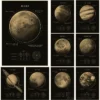Gazing into Our Galactic Past
When we peer up at the Milky Way’s misty band of light, we’re viewing it as it appeared in the Stone Age due to the vast distance involved. That’s because light from the galaxy’s center takes an estimated 25,000 years to reach our planet. This means we see the heart of our home galaxy as it was thousands of years in the past, when humans were just beginning to form civilizations.
The immense scale of the Milky Way makes this cosmic lag time possible. Our galaxy spans around 100,000 light-years across, with Earth situated two-thirds of the way from the galactic center. A light-year equals 6 trillion miles, the distance light travels in one Earth year. This staggering distance combined with the speed of light, about 186,000 miles per second, creates a long journey for light from the galaxy’s core.
When ancient hunter-gatherers gazed at the Milky Way’s celestial band 25,000 years ago, they viewed the same ancient photons of light that now enter our telescopes. The galaxy’s center hosts a supermassive black hole around 4 million times the Sun’s mass. But we only see it as it appeared when wooly mammoths still roamed Earth, not as it is today.
Peering Back Through Time
This peering back through time applies to all cosmic objects. The sun’s light, for example, is around 8 minutes old when it reaches us. For more distant bodies like the North Star, it’s several centuries old. We never see the universe in true real-time due to the delay of light traversing the cosmos.
This phenomena allowed 19th and 20th century astronomers to literally glimpse back into history and cosmology’s evolution. Edwin Hubble used telescope observations in the 1920s to prove galaxies exist beyond our own. His work showed the Milky Way is just one of billions of galaxies comprising our expanding universe.
Hubble measured light from other galaxies that left over 10 billion years ago. By analyzing the galaxies’ motion and distance, he could rewind cosmic history. His discoveries overturned the ancient geocentric model placing Earth at the universe’s center.
When we train giant telescopes like Hubble, Keck or XMM Newton at dazzling astronomical phenomena, we must account for the time shift. Supernova explosions or neutron star collisions we view live actually occurred hundreds, thousands, or millions of years in the past. The universe has marched onward since that light began its journey aeons ago.
An Expanding Cosmic Horizon
Our knowledge of the Milky Way and universe at large is thus destined to always run behind due to light’s plodding speed. As our technology improves, we’ll gather light from even more ancient eras of the cosmos. Light that left soon after the Big Bang, 13.8 billion years ago, is just reaching our experiments now, offering insights into the newborn universe.
Already, the farthest observable galaxies and supernovas reveal a younger, smaller cosmos unlike the Milky Way’s modern galactic neighborhoods. But even these infant galaxies were already mature by the time their just-arriving light was emitted. We can only extend our vision back so far before peering into a dark veil, unseen but ever present.
Yet steadily improving telescopes and detectors allow us to probe deeper into space and time. NASA’s upcoming James Webb Space Telescope, launching in 2021, will collect infrared light from the most distant stars and galaxies. By spectrally dissecting this ancient light, scientists can decode properties of the early universe like chemical composition, star formation, and the emergence of planetary systems.
The Milky Way, too, harbors many mysteries yet to unravel, hidden in light still on its way to our planet. Its supermassive black hole was likely brighter and more active in the past, influencing the orbits of nearby stars. Stellar explosions and gamma ray bursts illuminated the galaxy’s core long before Earth or our solar system existed. What exotic phenomena from the Milky Way’s formative years will finally reach our eyes centuries or millennia from now?
A Humbling Cosmic View
The next time you gaze upwards at the Milky Way’s cosmic beauty, consider the long journey that light took to meet your eyes. The stars and worlds you behold are ghosts from the past, some already perished since their shining light embarked.
Like ancient mariners peering across seas new and strange, we can never know the present state of galaxies revealed to us only by long-traveling light. But pondering the vast galaxies and eons spanned by a single night’s observations can provide a humbling and liberating perspective on humanity’s place in the grand scale of space and time. We are but fleeting witnesses to the infinite spectacle of the cosmos gradually unveiling through patient light.



